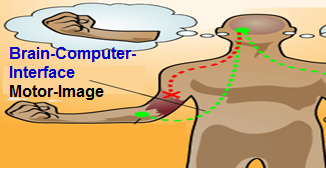Stroke is one of the leading serious long term disability causes in the world. Physical therapy approaches are the de facto rehabilitation for stroke treatment as after-stroke guidelines, which involve therapists to assist stroke patients in recovering their motor ability.
Current Treatment Rehabilitation Practices/Guidelines:
• Medicine
• Manual rehabilitation with therapists
• Robot-assisted rehabilitation
• Stimulation to the limbs
Challenges:
• More cases in the world especially in emerging countries
• No effective means of early rehab for severe cases
• Lack of available therapists
• Efficacy can be enhanced
Brain-computer interfaces (BCIs) acquire, analyze and translate brain signals into control commands of output devices.

Brain Computer Interface (BCI) has the prospects of helping stroke survivors to enable interaction with their environment through brain signals in place of the traditional nerve pathway training, and restoring motor functions by inducing activity-dependent brain plasticity.
This BCI-MI Rehabilitation research adopts the BCI technology developed through the A*STAR, Institute for Infocomm Research (I2R), in which the development team was awarded as the winner in the International BCI Competition in years 2005 and 2008.
There are two variants of BCI in the literature. The first generation of BCI established control by employing an operant conditioning approach whereby the subject had to learn to self-regulate a specific EEG feature that was hard-wired in the BCI system. This was similar to EEG-neurofeedback that employed the characteristics of a “one size fits all” appraoch. The next generation of BCI establishes control in the opposite way by adapting to the specific brain signals of each individual subject using advanced machine learning and signal processing techniques.
We have investigated the use of state-of-the-art subject-specific motor imagery BCI algorithm to detect performance of motor imagery for stroke rehabilitation. In the recent clinical trial, patients were randomized into standard arm therapy (SAT), SAT plus robotic therapy, and SAT plus BCI and robotic therapies. Our study also found that significantly larger improvements were observed in patients that received SAT plus BCI and robotic therapies.
The results from the above studies showed that BCI yielded improved performance compared to neurofeedback and biofeedback in stroke. This shows that the subject-specific approach from the use of BCI yielded better clinical efficacy compared to the “one size fits all” approach from neurofeedback in stroke rehabilitation.
Based on the new BCI generation, a new generation of BCI rehabilitation system will be built under the following prospects: